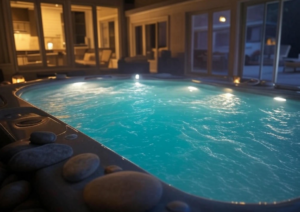How to Fight a Cold with the Power of a Hot Tub
Discover how a hot tub can help you feel better when you have a cold. This guide shows you the science, practical tips, and safe ways to use your hot tub for relief. You’ll learn how heat, steam, and relaxation work together to ease symptoms and boost your immune system.
Introduction
Imagine soaking in a warm hot tub when you feel under the weather. The heat, steam, and gentle massage may not cure your cold, but they can help ease symptoms like congestion, sore muscles, and a scratchy throat. When you have a cold, your body needs rest and care. A hot tub can support these needs by raising your core temperature slightly, much like a mild fever. This process can help your body make more white blood cells that fight off infections.
Many people feel better after a session in a hot tub because it can clear nasal passages, relax stiff muscles, and reduce stress. The steam you breathe in can loosen mucus, and the warmth can help your blood flow better. This makes it easier for your body to heal. Moreover, the relaxing effects can help you sleep better at night—a key part of recovery. When you sleep well, your body gets a chance to repair and boost its defenses.
In this post, you will learn about:
- How hot tubs work on a cold: The science behind heat and steam.
- Ways to use your hot tub safely: Practical steps to follow.
- Comparisons with other treatments: How hot tubs stack up against showers and steam rooms.
- Tips for long-term use and maintenance: Keeping your hot tub safe and effective.
- Expert FAQs and additional resources: Answers to common questions and where to learn more.
By the end of this guide, you will have a clear roadmap to safely enjoy the benefits of a hot tub during a cold. Let’s dive into the details of how you can use the power of warm water to fight off your cold symptoms.
“Relaxation is the key to a healthy body and mind.”
— Health Authority

Main Topic Exploration
The Science Behind Hot Tub Therapy
When you soak in a hot tub, warm water raises your body temperature. This small rise can mimic a mild fever. A mild fever helps your body fight viruses by boosting the production of white blood cells. White blood cells are your body’s defenders. They seek out and destroy viruses.
The heat from the hot tub also causes vasodilation. This means your blood vessels widen, which helps blood flow more easily. With better blood flow, oxygen and nutrients reach your muscles and organs faster. Improved circulation helps clear out waste and reduce inflammation.
How Steam Helps with Congestion
The steam that rises from the water is like a natural decongestant. When you breathe in the warm, moist air:
- It thins the mucus in your nasal passages.
- It soothes inflamed tissues.
- It helps clear out the airways.
This effect can make breathing easier and may relieve sinus pressure. The benefits are similar to those of a humidifier.

Relaxation and Pain Relief
Soaking in a hot tub can relax your muscles. The warm water soothes body aches and reduces tension. The jets in many hot tubs can massage sore spots. This can help ease pain and make you feel more comfortable.
Heat also reduces the signals that your brain receives about pain. This makes the discomfort from cold-related aches less severe. A relaxed body can fight illness better because stress weakens your immune system.
Boosting Your Immune System
By reducing stress, a hot tub can help lower cortisol levels. Cortisol is a hormone that, in high amounts, can make your immune system less effective. When you are relaxed, your body has more energy to focus on healing. This is why many experts suggest that stress relief is key to recovering from a cold.
Scientific Evidence and Expert Views
Experts agree that while a hot tub will not cure your cold, it offers supportive benefits. Studies on heat therapy show improvements in blood flow and muscle relaxation. Some experts point out that the benefits come from the combined effect of heat, steam, and relaxation. This combination may give you a much-needed boost while your body fights off the virus.
“Hydrotherapy can be a useful tool in managing cold symptoms.”
— Medical Expert
Custom Table: Hot Tub Benefits vs. Common Cold Symptoms
Custom Table: Hot Tub vs. Other Therapies
Diagram: How Hot Tub Therapy Works
Comparative Analysis
When you compare hot tubs with other cold relief methods, you see both strengths and limits. Here are the main factors to consider.
Cost and Effectiveness
-
Hot Tub:
Pros:- Offers a mix of heat, steam, and massage.
- Provides long-term relaxation.
Cons: - High initial cost.
- Not available to everyone.
-
Steam Room:
Pros:- Great for clearing congestion.
- Can be found in many gyms or spas.
Cons: - Does not offer massage benefits.
-
Warm Shower:
Pros:- Easy and low cost.
- Good for quick relief.
Cons: - Limited relaxation and decongestion time.
Accessibility and Practical Use
Hot tubs can be a luxury, but they work well if you already have one. A steam room or warm shower can be good alternatives when a hot tub is not available.
Summary Comparison Table with Color-Coding
Recommendations for Different Users
- Homeowners with a Hot Tub: Use your hot tub for regular relief.
- Those Without One: Consider warm showers or visiting a spa.
- Budget-Conscious Users: Warm showers are a low-cost option that still offer some relief.
Performance Factors
Your results depend on many factors. Here are the key points:
Variables That Affect Relief
-
Water Temperature:
Keeping the water between 100°F and 102°F is best. Too hot can be dangerous. -
Soak Duration:
Limit your soak to 15-20 minutes. Longer sessions can lead to dehydration. -
Hydration:
Drink water before, during, and after your session. -
Cleanliness:
Use a well-maintained hot tub to avoid germs. -
Essential Oils:
Use only a few drops of safe oils like eucalyptus for extra steam benefits.
Diagram: Factors and Their Effects
Actionable Strategies
- Set a timer: Use a timer to avoid soaking too long.
- Check water quality: Regularly clean your hot tub.
- Plan sessions: Use your hot tub at the first sign of symptoms.
Implementation Guide
Follow these steps to use your hot tub safely and get the best results.
-
Pre-Soak Preparation:
- Shower to remove dirt.
- Drink a glass of water.
- Check that the hot tub is clean.
-
Set the Temperature:
- Adjust the water to 100–102°F.
- Use a thermometer to check the temperature.
-
Add Enhancements (Optional):
- Add 2–3 drops of eucalyptus oil on the side.
- Do not put oil directly in the water.
-
Soak and Relax:
- Sit comfortably in the tub.
- Breathe slowly and deeply.
- Keep the session to 15–20 minutes.
-
Post-Soak Care:
- Dry off quickly.
- Wrap in a warm towel or robe.
- Drink another glass of water.
-
Repeat as Needed:
- You can do this 2–3 times a day.
- Always listen to your body.
Warning: Overheating can lead to dizziness. If you feel lightheaded, leave the tub immediately.
Tip from Experts: Always consult your doctor if you have a fever or heart issues before using a hot tub.

Troubleshooting Section
Even with careful use, problems can occur. Here are common issues and how to fix them.
Common Problems and Solutions
-
Dizziness or Lightheadedness:
Cause: Too hot or too long in the tub.
Solution: Leave the tub, cool down, and drink water. -
Dry Skin or Dehydration:
Cause: Extended exposure to heat.
Solution: Reduce soak time and use moisturizer after. -
Worsened Cold Symptoms:
Cause: Using the tub when you have a high fever.
Solution: Do not use the hot tub if your temperature is above 100.4°F. -
Poor Water Quality:
Cause: Insufficient cleaning.
Solution: Clean your hot tub regularly.
Step-by-Step Diagnostic Tips
- Check your body: If you feel unwell, stop using the tub.
- Measure water temperature: Ensure it is safe.
- Hydrate often: Drink water before and after each session.
- Review your session length: Stick to 15–20 minutes.
- Ask for help: If you feel worse, speak with a doctor.
“Listening to your body is the first step to a safe and healthy recovery.”
— Wellness Expert
Innovation and Extended Applications
Hot tub therapy is not just for colds. Here are some innovative uses and trends:
-
Post-Workout Recovery:
Many athletes use hot tubs to relax sore muscles after exercise. -
Stress Relief:
Regular sessions can lower stress levels and improve sleep. -
Joint Pain Management:
The buoyancy of the water can help reduce joint pressure. -
Aromatherapy:
Safe essential oils can boost the benefits of the steam for respiratory health. -
Future Trends:
Experts are exploring ways to combine hot tub therapy with smart technology. Imagine a hot tub that adjusts its temperature based on your body signals! -
Extended Hydrotherapy:
Some spas are merging hot tubs with cold plunge pools. This hot-cold contrast therapy can boost circulation further.
These trends show that the use of hot tubs goes beyond just colds. They can be a part of a regular health routine that supports both body and mind.
Long-term Considerations
When using a hot tub over time, think about these points:
-
Maintenance:
Keep the tub clean and check the water chemistry often. -
Safety Checks:
Regularly inspect your hot tub for any wear or damage. -
Energy Costs:
Consider the energy use and ways to reduce costs, like solar blankets. -
Upgrade Indicators:
If the tub no longer holds heat well, it might be time for a replacement. -
Cost-Benefit:
A well-maintained hot tub can be a long-term investment for your health and relaxation.
Expert FAQ Section
Q1: Can a hot tub cure a cold?
A1: No. A hot tub helps ease symptoms but does not kill the virus.
Q2: How long should I use the hot tub when sick?
A2: Limit your soak to 15–20 minutes per session and repeat 2–3 times a day.
Q3: Is it safe to add essential oils?
A3: Yes, but use only a few drops and make sure they are hot tub safe.
Q4: What should I do if I feel dizzy?
A4: Stop the session immediately, step out, and drink water.
Q5: How does the hot tub boost my immune system?
A5: The heat mimics a mild fever, which can trigger your body to produce more white blood cells.
Q6: Do I need to worry about the water quality?
A6: Yes. Always ensure the hot tub is clean and properly maintained to avoid infections.
Q7: What if I have a high fever?
A7: Avoid using the hot tub if your temperature is above 100.4°F. This can make you feel worse.
Conclusion
In this guide, you learned how a hot tub can help ease cold symptoms. The warmth and steam can reduce congestion, relax muscles, and boost your immune system. Remember, a hot tub is a tool for comfort and relief, not a cure for the cold virus. Follow safety tips such as limiting soak time and staying hydrated. Use your hot tub wisely as part of a broader care plan that includes rest and proper nutrition.
Now that you know the benefits and the safe practices, consider adding regular hot tub sessions to your wellness routine. If you do not own one, look into local spas or consider a warm shower as an alternative. The power of warm water is a simple way to help your body fight a cold and feel better sooner.
“Self-care is not a luxury, it is a necessity for health.”
— Health Organization
Take action today and enjoy the soothing benefits of hydrotherapy as part of your cold recovery plan.
Additional Resources
- Centers for Disease Control and Prevention (CDC)
- Mayo Clinic: Cold Remedies
- WebMD: Hot Tub Therapy
- Healthline: Benefits of Hydrotherapy
- National Center for Complementary and Integrative Health (NCCIH)
Technical Glossary
- Buoyancy: The force that allows objects to float in water.
- Circulation: The flow of blood throughout the body.
- Decongestion: The process of clearing blocked airways.
- Hydrotherapy: The use of water for pain relief and treatment.
- Immune Boost: The process of strengthening the body’s defense system.
- Mucus Thinning: Making thick mucus easier to clear.
- Thermotherapy: The use of heat for healing.
- Vasodilation: The widening of blood vessels to improve blood flow.
- White Blood Cells: Cells that fight infection.
- Xerosis: Dry skin, often caused by dehydration.
We hope this guide helps you use the power of a hot tub to fight your cold safely and effectively. Enjoy the warmth, breathe in the steam, and take a step toward better recovery today!
